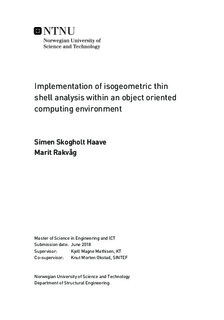Implementation of isogeometric thin shell analysis within an object oriented computing environment
Master thesis
Permanent lenke
http://hdl.handle.net/11250/2562325Utgivelsesdato
2018Metadata
Vis full innførselSamlinger
Sammendrag
The drawback in today's computational analysis in structural engineering is that design and analysis are not integrated in a unified platform. A majority of the time spent in structural analysis is used to transform a design model into an analysis suitable model. Furthermore, this process can induce a geometry which is based on approximations. Isogeometric analysis (IGA) was developed to remedy this loss of efficiency as it aims to unify the geometrical representation in both design and analysis. NURBS (Non-Uniform Rational B-Splines) are the most widespread mathematical basis in computer-aided design (CAD) as it is able to depict the geometry in an exact manner, which makes NURBS a suitable basis for an IGA.
The purpose of this thesis is to implement the isogeometric rotation-free Kirchhoff-Love thin shell element proposed by Kiendl et al. (2009), for both geometrically linear and nonlinear analyses within an object-oriented environment. The element is integrated into the open-source software IFEM Elasticity developed by SINTEF Digital, which is part of a research project devoted to merging design and analysis in computational mechanics.
To verify the implementation and the element's performance, a set of both linear and nonlinear benchmark problems have been simulated. The performance has been evaluated through a convergence study for the linear cases, while the nonlinear cases have been compared to results obtained by Lagrange-based finite element analysis (FEA) simulations. The results of the implemented shell element yielded a coherence with the reported results in relevant scientific publications.
